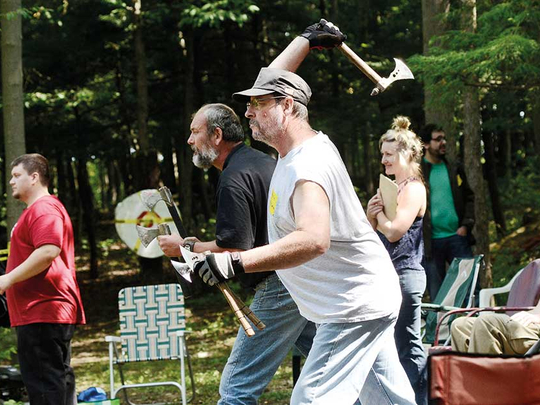
DANBY, N.Y. — Reaching the 2017 Finger Lakes Fling, held on the last weekend in August, required entering Paul Maccarone and Chris O’Brien’s driveway. Still in your car, you eased left onto their vast, flat front lawn, careful not to clip the three skinny maples. You minded the garden fence, guarded by pink flamingoes and watering cans.
You parked among the compact cars, campers and minivans from Massachusetts, Connecticut, New York and Ontario. Then you followed the reverberating ‘thunk’ to the couple’s 3-acre backyard. There, 23 men and women — divided by experience and ability — tossed knives and tomahawks for two days into increasingly splintered wooden targets. Sometimes the blades split playing cards or whizzed by a mannequin’s ear.
The event was sanctioned by the International Knife Throwers Hall of Fame (or IKTHOF, if you prefer), a 500-plus member organisation. It was less about competition than about sharing a single love that had various origins: among them, a knife that was a gift from a father to his child; one that came from a renaissance fair; or ones that were swiped from grandma’s kitchen, just to see what they could do.
“Most people think I’m nuts,” Jeff Perreault of Oswego, New York, said as he took his first throw.
The stigma of misunderstanding dissolves with each ‘thunk’. “We all want to hear that sound over and over and over,” said Jack Dagger (yes, that’s his real name), US director of the International Knife Throwers Hall of Fame, which is based in Austin, Texas. “We’re chasing just the sound of success. Every time we do it, it’s a reward and it dumps endorphins in our brain and it gives us immediate confirmation of a job well done — right there, right then.”
“Thunk junkies” drove hours to Maccarone and O’Brien’s house for the competition. “This is one thing we have in common,” said David Cox, a chef from Rowley, Massachusetts, who wore a crude knife tattoo on the inside of his left forearm, a result of blue ink, a sewing needle and thread, and the fact that he was 13 when he decided it would be a good idea to create it.
Knife-throwing has been big since the 1970s, contended Bobby Branton, who also makes knives. The internet’s emergence in the 1990s connected fellow aficionados and provided a forum for competition in virtual and real contests around the world.
As far as recognised champions in the sport, the Hall of Fame holds a three-day national throw every year to establish the best in various categories. Then again, the hall isn’t the only group of throwers; other champions exist, too. Someday perhaps, there will be a grand merger.
As for the typical knife-thrower, he or she is hard to describe, since anyone can throw.
“There’s really no ageing out,” said Rick Lemberg, an organiser of the online Aim Games, in which people compete by posting their scores. Because there is no physical contact, injuries are rare, he added. Commitment trumps physique. That is how Maccarone, who, in O’Brien’s words, is “built like a little fire hydrant,” can maintain a rivalry with a strapping, gregarious Canadian named Ward Wright. A healthy number of contestants at the Fling smoked. Cox’s equipment bag included two packs of Marlboro Special Blend 100s.
Yet knife-throwing — and its variations — linger on the fringe of professional sports. Contests amble. Participants approach the designated distance with the urgency of opening a door, size up the target and thrust their forearm forward. Take a few steps back. Repeat.
The sport can be described as a hybrid of archery, because people are aiming at a target from a distance, and darts, because a sharp object is being tossed.
“It’s kind of boring if you really look at it, because it’s ‘thunk’, ‘thunk’,” Branton said. “It’s exciting for people to throw and everything. But as far as a visual sport, it’s not.”
TV opportunities have been discussed, according to Maccarone and Dagger. “While we have yet to carry knife-throwing on ESPN, we’d consider it if there is an audience for coverage of this kind of competition and if the action is compelling,” Bill Hofheimer, ESPN’s senior director for communications, said in an email.
Is it dangerous? Actually, most of the knives used in throwing, Dagger said, resemble “weird-shaped tent pegs” — the tip is sharp because the handle and the blade are both held in making the toss. Overall, then, the knives are not that intimidating. In addition, someone is always designated to be a range master when throwing takes place to keep the target lanes clear of other people.
Contestants trickled in Friday afternoon, a promising development. Big guys, O’Brien said, had to help hang heavy targets bright with fresh red paint on the massive wooden backdrop.
For months, O’Brien, 50, and her husband had tackled details: registration, waivers (“by signing this form you give up important legal rights including the right to sue”), portable toilets. On this day, Maccarone was up at 6am and at the grocery store by 8am, losing an hour when the store’s fire alarm sounded.
“I won’t be relaxing at all,” he said, clutching a roll of caution tape. Ninety minutes later, he was manning a barbecue grill.
There were no sponsorships at this event. No paying attendees and no paid participants. And no prize money. Maccarone wanted to offer a nice venue to throw and to introduce more people to the sport. That included Eric Johnson, 64, who learnt about the event online and drove from Bridgeport, Connecticut. He was soon showing his bayonets to fellow first-timers Humphrey Tan, 33, and Ryan Dayaram, 34, co-workers at Stryke Target Range in Toronto.
The communal vibe lasted throughout the competition, which started on a cool, dewy Saturday morning. Everyone wore name tags. Canada and the United States were honoured with their national anthems — played on O’Brien’s smartphone as Maccarone held a portable speaker. “And no kneeling,” O’Brien said beforehand. (Everyone obliged.) “No throwing at the live trees,” Maccarone instructed. “I like my little forest.”
Boundaries were identified to keep guests on the sprawling, woodsy property and away from the neighbours. “They’re good neighbours,” he said. “And I’d like to keep it that way.”












